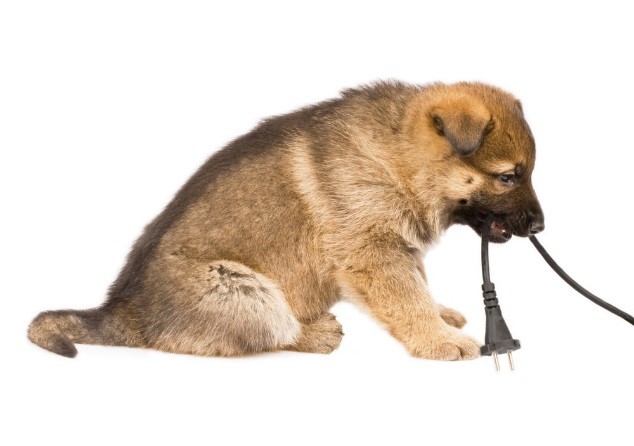-
Adopt
-
Veterinary Care
Services
Client Information
- What to Expect – Angell Boston
- Client Rights and Responsibilities
- Payments / Financial Assistance
- Pharmacy
- Client Policies
- Our Doctors
- Grief Support / Counseling
- Directions and Parking
- Helpful “How-to” Pet Care
Online Payments
Referrals
- Referral Forms/Contact
- Direct Connect
- Referring Veterinarian Portal
- Clinical Articles
- Partners in Care Newsletter
CE, Internships & Alumni Info
CE Seminar Schedule
Emergency: Boston
Emergency: Waltham
Poison Control Hotline
-
Programs & Resources
- Careers
-
Donate Now
 Jordana Fetto, DVM
Jordana Fetto, DVM
www.angell.org/emergency
emergency@angell.org
781-902-8400
MSPCA-Angell West, Waltham
Overview:
There are several causes of electrocution, but the most common form in companion animals is biting exposed electrical cords such as those for Christmas lights, floor fans, cable/internent and phone chargers. Less common causes include lightening strikes and exposure to downed, live power lines. While all companion animals live in an environment in which electical cords are readily available, it is young dogs and cats, aged 8 weeks to 2 years, that are more commonly affected as electrical cords are viewed as chew toys.
How does the injury occur:
An animal playing with an electrical cord bites on the cord and the electrical energy coursing through the wire is converted to heat at the site of contact with tissue. This results in a thermal burn. The electrical current may then pass through the animal’s body resulting in the disruption of normal functions such as heart rhythm and breathing. Severity of injury can range from mild to life threatening and it depends on the duration of exposure and the voltage of the electrical current.
Prognosis:
Prognosis refers to the likelihood of a complete recovery after sustaining an injury or illness. The prognosis for electrical cord injury varies depending on the severity of the injury sustained. For instance, animals with only burns to the mouth or other mild clinical signs have a good outcome, whereas animals that develop fluid accumulation within their lungs have survival rates between 40-85%. Unfortunately, most animals that develop cardiac arrest or unconsciousness as a result of the electrical injury do not survive.
Symptoms and Types of injury:
Two categories of injuries result from electrical cord injuries. First is the local injury which is typically a thermal burn. These burns occur at the site of contact with the electrical current, so in animals that bite the cord the burns are found in the mouth (lips, gums, tongue). Thermal burns can appear pale yellow, tan or gray in color. Systemic injuries are due to the electrical current coursing through the animal’s body and causing internal damage. They can range in severity from mild to life threatening and manifest as any of the following- vomiting, abdominal pain, muscle spasms, seizures, unconsciousness, respiratory distress, fluid accumulation in the lungs, irregular heart rate and rhythm, cardiac arrest, and sudden death.
Respiratory distress and development of fluid within the lungs, called non-cardiogenic pulmonary edema, is one of the more serious and potentially life threatening injuries. Signs of this include coughing, production of white/pink foam or fluid from the mouth and nose, difficulty breathing, and/or blue or grey colored gums. The onset of this complication can be delayed up to 12-36 hours, so close monitoring of your pet’s breathing rate and effort for several days is always warranted. If signs are seen, then immediate veterinary attention should be sought and chest x-rays performed. Treatment typically requires hospitalization with oxygen support and in very severe cases requires mechanical ventilation.
Another potentially serious and life threatening inury is irregular heart rhythm and rates. Heart irregularities can be immediate and short-lasting such that normal heart rate and rhythm will return on its own, have a delayed onset, or be fatal. Signs of abnormal heart rates and rhythms include agitated behavior, inability to settle, weakness, collapse, pale or grey gum color, and/or difficulty breathing. If these signs are observed, then immediate veterinary attention should be sought and an EKG be performed. Hospitalization for monitoring and administration of anti-arrhythmia medications is typically warranted.
What to do if your pet sustains an electrical injury:
First and foremost, DISCONNECT the electricity before touching your pet to prevent electrical injury to yourself or other members of the family. Now that it is safe to touch your pet, REMOVE him or her from the source of the electrical current and then check to make sure the nose and mouth are clear of fluid/mucous so that your pet is able to breath. Next, SEEK VETERINARY ATTENTION IMMEDIATELY regardless of how your pet is acting, but especially if your pet is having muscle spasms, seizures, difficulty breathing, weakness/collapse, or is unconscious.
Typically the diagnosis of electrical cord injury is made based on the history such that the owner saw the incident or the animal was found unconscious, convulsing or in respiratory distress near damaged electrical cords. Diagnostics that will be recommended include chest x-rays to look for evidence of pulmonary edema, full bloodwork to asses for damage to internal organs such as the liver and kidneys, and an electrocardiogram (EKG) to assess heart rate and rhythm. Due to the range in severity of electrical cord injury, the types of treatments that will be recommended and required for your pet to receive the best care will also vary on a case by case basis. Treatments range from out-patient supportive care with pain medications and antibiotics to hospitalization with oxygen therapy, IV fluids, and intensive monitoring to performance of CPR.
My pet has been discharged, now what?
At-home care for your pet will vary based on the severity and type of injury he or she has sustained. Since most animals have oral burns, for a period of 2 weeks until the burns heal it is recommended that only soft food, treats and toys be offered. Additionally, these animals will also go home with daily pain medications and possibly an antibiotic as well. Since there is a risk for the delayed onset of clinical signs and symptoms, it is strongly recommended that all animals be closely monitored and activity restricted for 2-3 days following discharge. Lastly, the emergency veterinarian or your local veterinarian may recommend a follow-up appointment. This is especially true if your pet developed pulmonary edema, as the purpose of the recheck appointment is to repeat chest x-rays to ensure appropriate resolution of the fluid within the lungs. If at any time your pet is declining at home or develops new signs, then immediate follow-up with a veterinarian is recommended.
For more information on the MSPCA-Angell West Emergency Service, please visit www.angell.org/emergency or call 781-902-8400.
Resources:
- Mann, F. A., DVM, MA, DACVS, DACVECC. “Electrical and Lightning Injuries.” Small Animal Critical Care Medicine. 2nd ed. St. Louis: Elsevier Saunders, 2015. 799-802. Print.
- Whelan, Megan. “Electrocution.” Ed. Elizabeth Rozanski.Clinical Veterinary Advisor Dogs and Cats. 2nd ed. St. Louis: Elsevier Saunders, 2011. 342-43. Print.